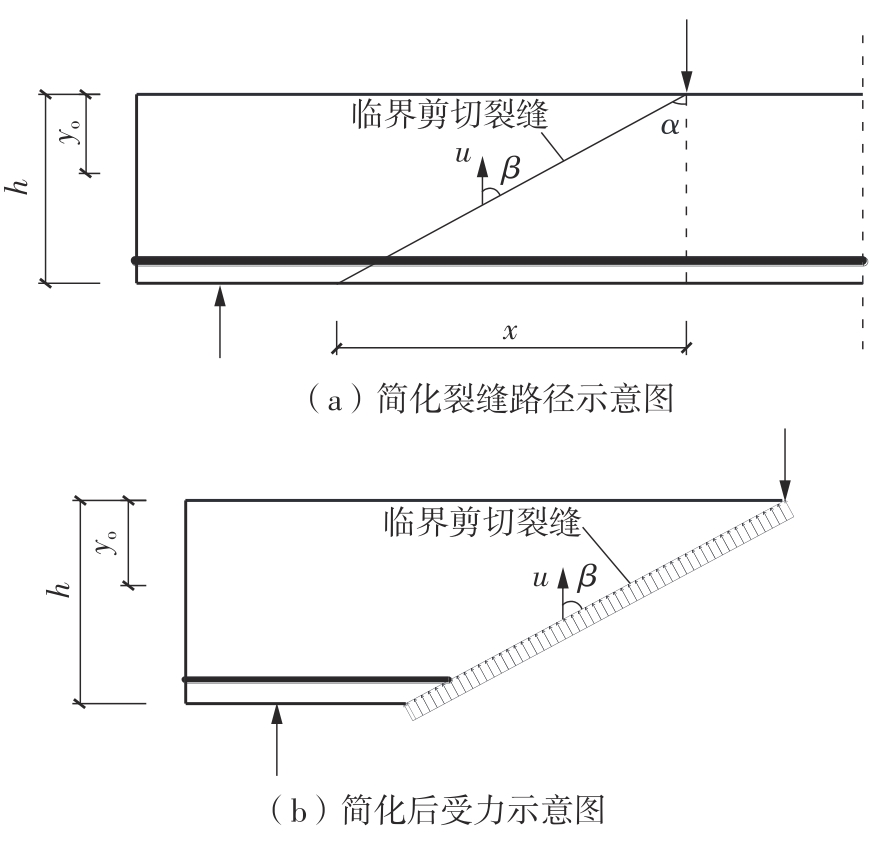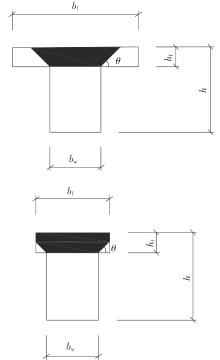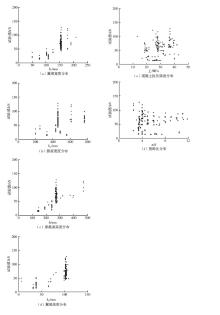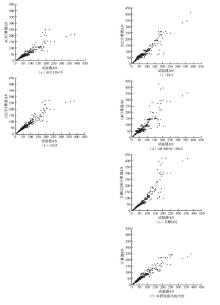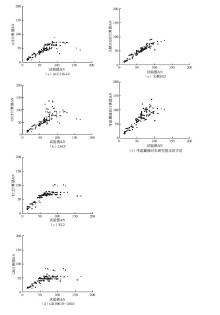华南理工大学学报(自然科学版) ›› 2024, Vol. 52 ›› Issue (5): 114-126.doi: 10.12141/j.issn.1000-565X.230238
基于裂缝滑移模型的无腹筋RC梁抗剪承载力计算
- 长安大学 建筑工程学院,陕西 西安 710061
-
收稿日期:2023-04-13出版日期:2024-05-25发布日期:2023-05-26 -
通信作者:熊二刚(1980-),男,博士,教授,博士生导师,主要从事工程结构抗震研究。 E-mail:xerg@chd.edu.cn -
作者简介:巩忠文(1997-),男,博士生,主要从事工程结构抗震研究。E-mail: 13571962851@163.com -
基金资助:陕西省重点研发计划项目(2021SF-461)
Shear Strength Calculation of RC Beams Without Shear Reinforcement Based on Crack Sliding Model
GONG Zhongwen( ), XIONG Ergang(
), XIONG Ergang( ), WANG Wenxiang, CAO Tao, FU Chongyang
), WANG Wenxiang, CAO Tao, FU Chongyang
- School of Civil Engineering,Chang’an University,Xi’an 710061,Shaanxi,China
-
Received:2023-04-13Online:2024-05-25Published:2023-05-26 -
Contact:熊二刚(1980-),男,博士,教授,博士生导师,主要从事工程结构抗震研究。 E-mail:xerg@chd.edu.cn -
About author:巩忠文(1997-),男,博士生,主要从事工程结构抗震研究。E-mail: 13571962851@163.com -
Supported by:the Key R&D Project of Shaanxi Province(2021SF-461)
摘要:
为了考虑翼缘对无腹筋钢筋混凝土(RC)梁抗剪承载力的影响,基于裂缝滑移模型,考虑了受压区的贡献、销栓作用贡献和受拉区骨料咬合作用的贡献,提出了一种无腹筋RC梁抗剪承载力计算公式。为验证该计算公式的准确性,分别应用该公式和国内外规范对收集的444根矩形截面梁与172根T形截面梁的试验数据进行计算,并将结果与国内外规范计算结果进行对比;基于所收集的数据集,利用5种常用的机器学习算法对收集的数据集进行回归分析,在数据集较小的情况下验证各算法的拟合度。结果表明:各国规范提出的抗剪承载力计算公式与试验值吻合较好;相较于规范的计算方法,该研究提出的计算方法较为准确,且可以有效地考虑T形截面梁翼缘对于抗剪承载力的贡献;选取的5个机器学习算法在测试集上表现良好,且与计算结果表现出了相同的规律,验证了机器学习算法在数据集较小的情况下对钢筋混凝土梁抗剪承载力计算的适用性。
中图分类号:
引用本文
巩忠文, 熊二刚, 王文翔, 等. 基于裂缝滑移模型的无腹筋RC梁抗剪承载力计算[J]. 华南理工大学学报(自然科学版), 2024, 52(5): 114-126.
GONG Zhongwen, XIONG Ergang, WANG Wenxiang, et al. Shear Strength Calculation of RC Beams Without Shear Reinforcement Based on Crack Sliding Model[J]. Journal of South China University of Technology(Natural Science Edition), 2024, 52(5): 114-126.
表2
T梁数据集分布"
| 参考文献 | 数据量 | bf /mm | bw /mm | hf /mm | h/mm | a/d | ρw /% | dg /mm | fc /MPa | φ/mm |
|---|---|---|---|---|---|---|---|---|---|---|
| ACIdatabase[ | 40 | 330.2~609.6 | 76.2~177.8 | 6.35~101.5 | 139.7~469.9 | 7.4~2.5 | 1.473~4.091 | 6.4~19.0 | 13.23~43.11 | 9.5~28.7 |
| Kani等[ | 123 | 457~762 | 208~152 | 99~109 | 252~280 1) | 2.50~14.16 | 1.7~9.5 | — | 18.48~40.22 | — |
| Thamrin等[ | 9 | 250~610 | 50~190 | 65~102 | 212~399 1) | 3.3~10.4 | 0.49~5.20 | — | 32~40 | — |
| 1 | Mac GREGOR G J, HANSON M J .The shear strength of reinforced concrete members[J].ACI Journal,1973,99(6):471-473. |
| 2 | Committee ASCE-ACI 445 on shear and Torsion.Recent approaches to shear design of structural concrete[J].Journal of Structural Engineering,1998,124(12):1375-1417. |
| 3 | 戚家南,王景全 .考虑翼缘影响的钢筋混凝土T梁抗剪承载力[J].东南大学学报(自然科学版),2019,49(4):638-644. |
| QI Jianan, WANG Jingquan .Shear strength of reinforced concrete T-beams considering the effect of flange[J].Journal of Southeast University (Natural Science Edition),2019,49(4):638-644. | |
| 4 | 易伟建 .混凝土结构试验与理论研究[M].北京:科学出版社,2012. |
| 5 | 冯浩雄,易伟建 .考虑翼缘有效宽度的钢筋混凝土T梁的抗剪承载力[J].江苏大学学报(自然科学版),2016,37(4):462-466. |
| FENG Haoxiong, YI Weijian .Shear strength of reinforced concrete T beams considering effective flange width[J].Journal of Jiangsu University (Natural Science Edition),2016,37(4):462-466. | |
| 6 | GIACCIO C, Al-MAHAIDI R, TAPLIN G .Experimental study on the effect of flange geometry on the shear strength of reinforced concrete T-beams subjected to concentrated loads[J].Canadian Journal of Civil Engineering,2002,29(6):911-918. |
| 7 | LIU J, GAO Z .A comparative study of models for shear strength of reinforced concrete T-beams[J].Structures,2022,35:922-930. |
| 8 | PLACAS A, REGAN P E .Shear failure of reinforced concrete beams[J].ACI Journal,1971,68(10):763-773. |
| 9 | RIBAS GONZALEZ C R, FERNÁNDEZ RUIZ M .Influence of flanges on the shear-carrying capacity of reinforced concrete beams without web reinforcement[J].Structural Concrete,2017,18(5):720-732. |
| 10 | ZARARIS I P, KARAVEZIROGLOU M K, ZARARIS P D .Shear strength of reinforced concrete T-beams [J].ACI Structural Journal,2006,103(5):693-700. |
| 11 | CLADERA A, MARÍ A, RIBAS C,et al .Predicting the shear-flexural strength of slender reinforced concrete T and I shaped beams[J].Engineering Structures,2015,101:386-398. |
| 12 | KOTSOVOU G M, COTSOVOS D M .Shear failure criterion for RC T-beams[J].Engineering Structures,2018,160:44-55. |
| 13 | ZHANG T, OEHLERS D J, VISINTIN P .Shear strength of FRP RC beams and one-way slabs without stirrups[J].Journal of Composites for Construction,2014,18(5):04014007/1-15. |
| 14 | RAHMAN J, AHMED K S, KHAN N I,et al .Data-driven shear strength prediction of steel fiber reinforced concrete beams using machine learning approach[J].Engineering Structures,2021,233:111743/1-22. |
| 15 | CHOU J S, PHAM T P T, NGUYEN T K,et al .Shear strength prediction of reinforced concrete beams by baseline,ensemble,and hybrid machine learning models[J].Soft Computing,2020,24(5):3393-3411. |
| 16 | YU Y, ZHAO X, XU J,et al .Machine learning-based evaluation of shear capacity of recycled aggregate concrete beams[J].Materials,2020,13(20):4552/1-32. |
| 17 | CASTILLO R, OKUMUS P, KHORASANI N E,et al .Machine learning for shear strength of reinforced concrete beams[J].ACI Structural Journal,2022,119(5):83-94. |
| 18 | ZHANG J, SUN Y, LI G,et al .Machine-learning-assisted shear strength prediction of reinforced concrete beams with and without stirrups[J].Engineering with Computers,2022,38(2):1293-1307. |
| 19 | NIELSEN M P, HOANG L C .Limit analysis and concrete plasticity[M].Abingdon:CRC Press,2011. |
| 20 | ZHANG J P .Strength of cracked concrete,part 1:shear strength of conventional reinforced concrete beams,deep beams,corbels,and prestressed reinforced concrete beams without shear reinforcement[M].Lyngby:Danmarks Tekniske Universitet,1994. |
| 21 | CHOI K K, KIM J C, PARK H G .Shear strength model of concrete beams based on compression zone failure mechanism[J].ACI Structural Journal,2016,113(5):1095-1106. |
| 22 | ZARARIS P D, PAPADAKIS G C .Diagonal shear failure and size effect in RC beams without web reinforcement[J].Journal of Structural Engineering,2001,127(7):733-742. |
| 23 | MUTTONI A, FERNÁNDEZ RUIZ M .Shear strength of members without transverse reinforcement as function of critical shear crack width[J].ACI Structural Journal,2008,105(2):163-172. |
| 24 | WALRAVEN J C .Fundamental analysis of aggregate interlock[J].Journal of the Structural Division,1981,107(11):2245-2270. |
| 25 | AUTRUP F, JOERGENSEN H B .Shear capacity of RC members without shear reinforcement:a modified crack sliding model[J].Engineering Structures,2021,239:112147/1-13. |
| 26 | KRAGH-Poulsen J C, NIELSEN M P, GOLTERMANN P .Shear strength of straight concrete members without shear reinforcement.reassessment of the effectiveness factors used in the crack sliding theory[J].Structural Concrete,2020,21(3):966-982. |
| 27 | VECCHIO F J, COLLINS M P .The modified compression-field theory for reinforced concrete elements subjected to shear[J].ACI Journal,1986,83(2):219-231. |
| 28 | REINECK K H .Ultimate shear force of structural concrete members without transverse reinforcement derived from a mechanical model (SP-885)[J].ACI Structural Journal,1991,88(5):592-602. |
| 29 | HUBER P, HUBER T, KOLLEGGER J .Investigation of the shear behavior of RC beams on the basis of measured crack kinematics[J].Engineering Structures,2016,113:41-58. |
| 30 | MÖRSCH E .Der Eisenbetonbau,seine theorie und anwendung[M].Stuttgart:Wittwer,1923. |
| 31 | YANG Y, WALRAVEN J, UIJL J .Shear behavior of reinforced concrete beams without transverse reinforcement based on critical shear displacement[J].Journal of Structural Engineering,2017,143(1):04016146/1-13. |
| 32 | REGAN P E .Research on shear:a benefit to humanity or a waste of time?[J].Structural Engineer,1993,71(19):337-346. |
| 33 | TUREYEN A K, WOLF T S, FROSCH R J .Shear strength of reinforced concrete T-beams without transverse reinforcement[J].ACI Structural Journal,2006,103(5):656-663. |
| 34 | GIACCIO C, Al-MAHAIDI R, TAPLIN G .Flange strain measurement in shear critical RC T-beams[J].Advances in Structural Engineering,2006,9(4):491-505. |
| 35 | REINECK K H, BENTZ E C, FITIK B,et al .ACI-DAfStb database of shear tests on slender reinforced concrete beams without stirrups[J].ACI Structural Journal,2013,110(5):867-876. |
| 36 | KANI M W, HUGGINS M W, WITTKOPP R R .Kani on shear in reinforced concrete[D].Toronto:University of Toronto,1979. |
| 37 | THAMRIN R, TANJUNG J, ARYANTI R,et al .Shear strength of reinforced concrete T-beams without stirrups[J].Journal of Engineering Science and Technology,2016,11(4):548-562. |
| 38 | 混凝土结构设计规范: [S]. |
| 39 | Building code requirement for structural concrete and commentary:ACI 318-19 [S]. |
| 40 | Eurocode 2:design for concrete structures-part 1:general rules and rules for buildings:EN 1992-1-1:2004 [S]. |
| 41 | MUTTONI A .Schubfestigkeit und durchstanzen von platten ohne querkraftbewehrung[J].Beton-und Stahlbetonbau,2003,98(2):74-84. |
| 42 | ZSUTTY T C .Beam shear strength prediction by analysis of existing data[J].ACI Journal,1968,65(1):943-951. |
| [1] | 赵建东, 许慧玲, 吕行, 等. 考虑代价敏感的高速公路偷逃费行为识别模型[J]. 华南理工大学学报(自然科学版), 2024, 52(5): 10-19. |
| [2] | 李百建, 黄炎, 符锌砂. 波纹钢形状与拱效应对加固盖板涵承载力的影响[J]. 华南理工大学学报(自然科学版), 2024, 52(1): 110-118. |
| [3] | 谢肖礼, 勾文鑫, 庞木林, 等. RC刚架拱桥的板桁组合加固及动力特性[J]. 华南理工大学学报(自然科学版), 2023, 51(4): 31-43. |
| [4] | 周楚昊, 林培群, 闫明月. 基于自监督学习的交通数据补全算法[J]. 华南理工大学学报(自然科学版), 2023, 51(4): 101-114. |
| [5] | 董萍, 韦述阳, 刘明波. 多网络协作下电动汽车参与电力市场的调度策略[J]. 华南理工大学学报(自然科学版), 2023, 51(12): 83-94. |
| [6] | 王晓飞, 李思雨, 陈迷, 等. 平凸曲线组合均衡性对公路安全性的影响[J]. 华南理工大学学报(自然科学版), 2022, 50(7): 76-84. |
| [7] | 宋建, 王文龙, 李东, 等. 基于Stacking集成学习的注塑件尺寸预测方法[J]. 华南理工大学学报(自然科学版), 2022, 50(6): 19-26. |
| [8] | 林培群 夏雨 周楚昊. 引入时空特征的高速公路行程时间预测方法[J]. 华南理工大学学报(自然科学版), 2021, 49(8): 1-11. |
| [9] | 贾若, 戴昇宏, 黄霓, 等. 交通拥堵判别方法研究综述[J]. 华南理工大学学报(自然科学版), 2021, 49(4): 124-139. |
| [10] | 赵静, 王选仓, 樊振阳, 等. 基于支持向量机的沥青路面性能评价[J]. 华南理工大学学报(自然科学版), 2020, 48(9): 116-123. |
| [11] | 张子烨, 李明畅, 梁凌睿, 等. 推荐系统信息跨领域的改进迁移学习算法[J]. 华南理工大学学报(自然科学版), 2020, 48(11): 99-106. |
| [12] | 熊二刚, 祖坤, 张倩, 等. 基于压力路径法的 RC 梁受力性能试验研究[J]. 华南理工大学学报(自然科学版), 2020, 48(10): 56-66,87. |
| [13] | 劳晓杰 韩小雷 季静 姜正荣 陈彬彬. CFRP 约束损伤钢筋混凝土的轴压性能[J]. 华南理工大学学报(自然科学版), 2019, 47(7): 1-9. |
| [14] | 胡建军 曹卓 但雅波 牛程程 李想 钱松荣. 基于特征选择和机器学习的材料弹性性能预测[J]. 华南理工大学学报(自然科学版), 2019, 47(5): 48-55. |
| [15] | 周晓宇 马如进 陈艾荣. 行车落物冲击下钢筋混凝土桥面板的安全性能 [J]. 华南理工大学学报(自然科学版), 2018, 46(4): 137-145. |
| 阅读次数 | ||||||
|
全文 |
|
|||||
|
摘要 |
|
|||||

